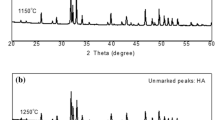Abstract
The influence of silicon-substituted hydroxyapatite (Si-HAp) on osteogenic differentiation was assessed by biological analysis. Si-HAp was prepared by ultrasonic spray pyrolysis (USSP) technique using various amounts of Si (0, 0.8, and 1.6 mass%). Chemical analysis revealed that Si was incorporated into the hydroxyapatite (HAp) lattice with no other crystalline phase and which caused the change of crystal structure. Biological analyses showed that the Si contents affected the cell proliferation and morphology, suggesting that there is an optimal Si content for cell culture. As for differentiation, alkaline phosphatase activity and osteocalcin production of Si-HAp were higher than those of HAp. Gene expression profiles also revealed that substitution of Si (0.8 mass%) up-regulated the expression levels of osteocalcin and especially Runx2, a master gene for osteoblast development. These results suggest that incorporating Si into the HAp lattice may enhance the bioactivity, particularly during early osteoblast development.







Similar content being viewed by others
References
LeGeros RZ. Properties of osteoconductive biomaterials: calcium phosphates. Clin Orthop Relat Res. 2002;395:81–98.
Vallet-Regi M, Arcos D. Silicon substituted hydroxyapatites. A method to upgrade calcium phosphate based implants. J Mater Chem. 2005;15:1509–16.
Pietak AM, Reid JW, Stott MJ, Sayer M. Silicon substitution in the calcium phosphate bioceramics. Biomaterials. 2007;28:4023–32.
Hoppe A, Guldal NS, Boccaccini AR. A review of the biological response to ionic dissolution products from bioactive glasses and glass-ceramics. Biomaterials. 2011;32:2757–74.
El Ghannam A. Bone reconstruction: from bioceramics to tissue engineering. Expert Rev Med Devices. 2005;2:87–101.
Carlisle EM. Silicon: a possible factor in bone calcification. Science. 1970;167:279–80.
Carlisle EM. Silicon: essential element for chick. Science. 1972;178:619–21.
Xynos ID, Edgar AJ, Buttery LDK, Hench LL, Polak JM. Ionic products of bioactive glass dissolution increase proliferation of human osteoblasts and induce insulin-like growth factor II mRNA expression and protein synthesis. Biochem Biophys Res Commun. 2000;276:461–5.
Botelho CM, Brooks RA, Best SM, Lopes MA, Santos JD, Rushton N, Bonfield W. Human osteoblast response to silicon-substituted hydroxyapatite. J Biomed Mater Res A. 2006;79A:723–30.
Hing KA, Revell PA, Smith N, Buckland T. Effect of silicon level on rate, quality and progression of bone healing within silicate-substituted porous hydroxyapatite scaffolds. Biomaterials. 2006;27:5014–26.
Bohner M. Silicon-substituted calcium phosphates: a critical view. Biomaterials. 2009;30:6403–6.
Gibson IR, Best SM, Bonfield W. Chemical characterization of silicon-substituted hydroxyapatite. J Biomed Mater Res. 1999;44:422–8.
Kim SR, Lee JH, Kim YT, et al. Synthesis of Si, Mg substituted hydroxyapatites and their sintering behaviors. Biomaterials. 2003;24:1389–98.
Tang XL, Xiao XF, Liu RF. Structural characterization of silicon-substituted hydroxyapatite synthesized by a hydrothermal method. Mater Lett. 2005;59:3841–6.
Balamurugan A, Rebelo AHS, Lemos AF, Rocha JHG, Ventura JMG, Ferreira JMF. Suitability evaluation of sol-gel derived Si-substituted hydroxyapatite for dental and maxillofacial applications through in vitro osteoblasts response. Dent Mater. 2008;24:1374–80.
Kikushima K, Yoshihisa A, Aizawa M. Characterization of silicon-substituded hydroxyapatite powders prepared by ultrasonic spray–pyrolysis technique. Bioceramics. 2009;22:79–82.
Aizawa M, Itatani K, Okada I. Syntheses of various apatites and porous coating of biocompatible calcium-phosphate films via spray–pyrolysis technique. Phosphorus Res Bull. 2006;20:61–78.
Aizawa M, Hanazawa T, Itatani K, Howell FS, Kishioka A. Characterization of hydroxyapatite powders prepared by ultrasonic spray-pyrolysis technique. J Mater Sci. 1999;34:2865–73.
Honda M, Kikushima K, Konishi T, et al. Cell proliferation, morphology and differentiation of transgenic-cloned pig calvarial osteoblasts on the silicon-substituted hydorxyapatite ceramics fabricated via ultrasonic spray-pyrolysis technique. J Aust Ceram Soc. 2011;47:37–41.
Carlisle EM. In vivo requirement for silicon in articular cartilage and connective tissue formation in the chick. J Nutr. 1976;106:478–84.
Reffitt DM, Ogston N, Jugdaohsingh R, et al. Orthosilicic acid stimulates collagen type 1 synthesis and osteoblastic differentiation in human osteoblast-like cells in vitro. Bone. 2003;32:127–35.
Zou S, Ireland D, Brooks RA, Rushton N, Best S. The effects of silicate ions on human osteoblast adhesion, proliferation, and differentiation. J Biomed Mater Res B. 2009;90B:123–30.
Langstaff S, Sayer M, Smith TJ, Pugh SM, Hesp SA, Thompson WT. Resorbable bioceramics based on stabilized calcium phosphates. Part I: rational design, sample preparation and material characterization. Biomaterials. 1999;20:1727–41.
Gomes S, Renaudin G, Mesbah A, et al. Thorough analysis of silicon substitution in biphasic calcium phosphate bioceramics: a multi-technique study. Acta Biomater. 2010;6:3264–74.
Botelho CM, Lopes MA, Gibson IR, Best SM, Santos JD. Structural analysis of Si-substituted hydroxyapatite: zeta potential and X-ray photoelectron spectroscopy. J Mater Sci Mater Med. 2002;13:1123–7.
Schroeder TM, Jensen ED, Westendorf JJ. Runx2: a master organizer of gene transcription in developing and maturing osteoblasts. Birth Defects Res C Embryo Today. 2005;75:213–25.
Thian ES, Ahmad Z, Huang J, et al. The role of surface wettability and surface charge of electrosprayed nanoapatites on the behaviour of osteoblasts. Acta Biomater. 2010;6:750–5.
Zhu XD, Zhang HJ, Fan HS, Li W, Zhang XD. Effect of phase composition and microstructure of calcium phosphate ceramic particles on protein adsorption. Acta Biomater. 2010;6:1536–41.
Coelho MJ, Fernandes MH. Human bone cell cultures in biocompatibility testing. Part II: effect of ascorbic acid, beta-glycerophosphate and dexamethasone on osteoblastic differentiation. Biomaterials. 2000;21:1095–102.
Guth K, Buckland T, Hing KA. Silicon dissolution from microporous silicon substituted hydroxyapatite and its effect on osteoblast behaviour. Key Eng Mater. 2006;309–311:117–20.
Curtis A, Wilkinson C. Topographical control of cells. Biomaterials. 1997;18:1573–83.
Author information
Authors and Affiliations
Corresponding author
Rights and permissions
About this article
Cite this article
Honda, M., Kikushima, K., Kawanobe, Y. et al. Enhanced early osteogenic differentiation by silicon-substituted hydroxyapatite ceramics fabricated via ultrasonic spray pyrolysis route. J Mater Sci: Mater Med 23, 2923–2932 (2012). https://doi.org/10.1007/s10856-012-4744-x
Received:
Accepted:
Published:
Issue Date:
DOI: https://doi.org/10.1007/s10856-012-4744-x




